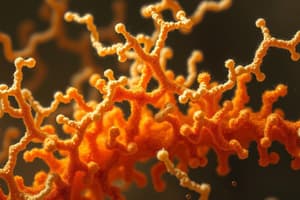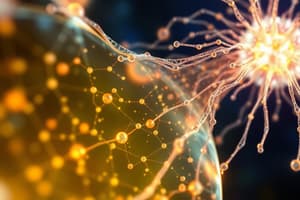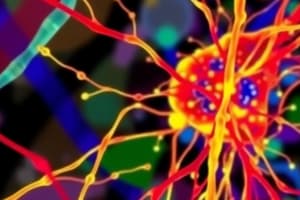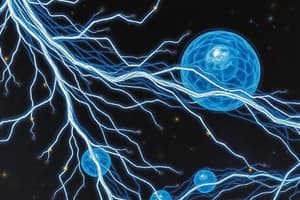Podcast
Questions and Answers
Question 1
Question 1
How do micro-cutting techniques help distinguish between pushing and pulling mechanisms in the cell?
Answer 1
Answer 1
Micro-cutting techniques can perturb the force balance in the structure of interest to distinguish between pushing and pulling mechanisms.
Question 2
Question 2
What is the role of astral microtubules during anaphase B?
Answer 2
Answer 2
Question 3
Question 3
Answer 3
Answer 3
Flashcards are hidden until you start studying
Study Notes
Microtubule-based pushing forces in the cell
- Micro-cutting techniques can distinguish between pushing and pulling mechanisms in the cell by perturbing the force balance in the structure of interest.
- Microtubules in the budding yeast push against the cell cortex during interphase, propelling the nucleus in the opposite direction.
- Microtubules in cylindrically shaped cells of the fission yeast exert a pushing force on the nucleus upon reaching the cell tips, keeping it at the cell center.
- The ability of microtubule pushing forces to center the nucleus depends on the arrangement of microtubules, besides its dependence on microtubule dynamics and cell geometry.
- In S. pombe, interphase microtubules exert pushing forces against the cell tips to position the duplicated spindle pole body in the cell center during spindle movements.
- During anaphase B, astral microtubules grow from the spindle pole bodies and help to align the spindle with the cell axis by pushing against the cell sides.
- Microtubules can push on the chromosomes in the spindle, generating polar ejection forces that push chromosome arms away from the proximal spindle pole.
- The chromokinesin Kid is the molecular entity generating polar ejection forces by walking towards the microtubule plus-end, which points away from the spindle pole.
- The plus-end directed motor CENP-E binds the chromosome at the kinetochore and slides it along another microtubule bound to the kinetochore of another chromosome.
- Microtubule-based pushing forces not only involve pushing an organelle away from the spindle pole, but also sliding an organelle along a microtubule.
- Microtubule pushing forces are dependent on the arrangement of microtubules, microtubule dynamics, and cell geometry.
- Micro-cutting techniques have been applied to spindles and other microtubule-based structures in a variety of cell systems.
Studying That Suits You
Use AI to generate personalized quizzes and flashcards to suit your learning preferences.




